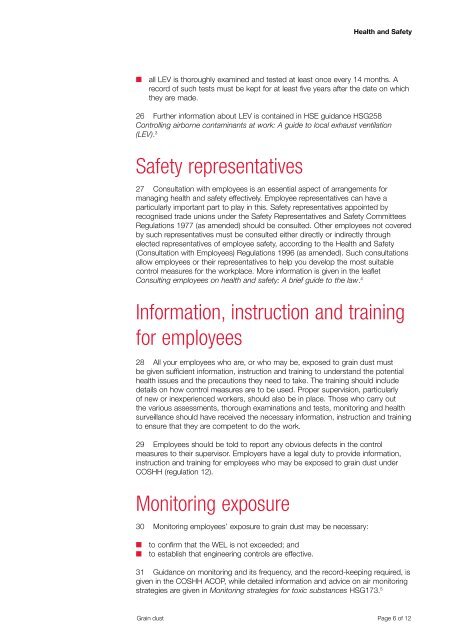Grain dust EH66 - HSE
Grain dust EH66 - HSE
Grain dust EH66 - HSE
Create successful ePaper yourself
Turn your PDF publications into a flip-book with our unique Google optimized e-Paper software.
Health and Safety<br />
■■<br />
all LEV is thoroughly examined and tested at least once every 14 months. A<br />
record of such tests must be kept for at least five years after the date on which<br />
they are made.<br />
26 Further information about LEV is contained in <strong>HSE</strong> guidance HSG258<br />
Controlling airborne contaminants at work: A guide to local exhaust ventilation<br />
(LEV). 3<br />
Safety representatives<br />
27 Consultation with employees is an essential aspect of arrangements for<br />
managing health and safety effectively. Employee representatives can have a<br />
particularly important part to play in this. Safety representatives appointed by<br />
recognised trade unions under the Safety Representatives and Safety Committees<br />
Regulations 1977 (as amended) should be consulted. Other employees not covered<br />
by such representatives must be consulted either directly or indirectly through<br />
elected representatives of employee safety, according to the Health and Safety<br />
(Consultation with Employees) Regulations 1996 (as amended). Such consultations<br />
allow employees or their representatives to help you develop the most suitable<br />
control measures for the workplace. More information is given in the leaflet<br />
Consulting employees on health and safety: A brief guide to the law. 4<br />
Information, instruction and training<br />
for employees<br />
28 All your employees who are, or who may be, exposed to grain <strong>dust</strong> must<br />
be given sufficient information, instruction and training to understand the potential<br />
health issues and the precautions they need to take. The training should include<br />
details on how control measures are to be used. Proper supervision, particularly<br />
of new or inexperienced workers, should also be in place. Those who carry out<br />
the various assessments, thorough examinations and tests, monitoring and health<br />
surveillance should have received the necessary information, instruction and training<br />
to ensure that they are competent to do the work.<br />
29 Employees should be told to report any obvious defects in the control<br />
measures to their supervisor. Employers have a legal duty to provide information,<br />
instruction and training for employees who may be exposed to grain <strong>dust</strong> under<br />
COSHH (regulation 12).<br />
Monitoring exposure<br />
30 Monitoring employees’ exposure to grain <strong>dust</strong> may be necessary:<br />
■■<br />
■■<br />
to confirm that the WEL is not exceeded; and<br />
to establish that engineering controls are effective.<br />
31 Guidance on monitoring and its frequency, and the record-keeping required, is<br />
given in the COSHH ACOP, while detailed information and advice on air monitoring<br />
strategies are given in Monitoring strategies for toxic substances HSG173. 5<br />
<strong>Grain</strong> <strong>dust</strong> Page 6 of 12
















